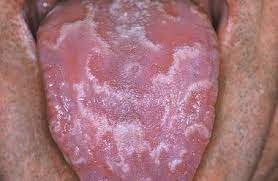What is geographic tongue?
Geographic tongue, also called benign migratory glossitis or annulus migrans, is a harmless condition on the surface of the tongue where some patches of the tongue are missing papillae (small pinkish-white bumps that are almost hair-like).
geographic tongue
Symptoms of geographic tongue can include:
Smooth red patches that may change size and location
Pain on tongue when eating salty or spicy food
Sometimes does not have any discomfort other than visual changes on the tongue surface
What causes geographic tongue?
Causes of geographic tongue are mostly unknown as it can occur spontaneously since early childhood and is fairly common. However, some research shows it can be due to several pathological factors such as:
Infections
Allergies
Nutritional deficiency
Mouth injuries
Autoimmune conditions
Psoriasis
Is geographic tongue something to worry about?
Geographic tongue, depending on the severity, may cause some discomfort when patients eat spicy, salty food or drink alcohol. Nonetheless, it does not cause significant health issues.
Can geographic tongue be a symptom of something else such as cancer?
Geographic tongue is a non-cancerous disorder and will not cause cancer, or any other serious infections if you know how to maintain your teeth.
A cancer on the tongue may be more localised to a single area and is often more prominent and easy to see.
A side area of the tongue where cancer is localised mostly, shown as two wide patches and signs of ulceration. the cancer lump may bleed if bitten or touched.
Several tests are required to diagnose tongue cancer. This includes a tongue biopsy to confirm cancer cells. The doctor may order additional tests such as PET Scan, X-rays of mouth and throat such as CT Scan (a type of X-ray showing thin sections or slides of the concerned areas).
Tongue cancer is more common in patients over 40 years old. Treatment of tongue cancer usually involves radiation therapy, chemotherapy, or a combination of both. Surgery may also be advised by the treating doctor if found necessary.
What is candidiasis, glossitis, and oral thrush? How is it related to geographic tongue?
Oral thrush, also called candidiasis, is a mouth infection caused by a yeast fungus. The infection may spread to the tongue, causing a white, fuzzy-like appearance at the inner base. This may resemble geographic tongue physically. However, oral thrush may present with different clinical symptoms.
Many people have candida present in their mouth without experiencing any problems. Causes of oral thrush may include:
Poor dental hygiene
Diabetes
Chronic illness
Using immunosuppressants or are immunosuppressed (HIV/AIDS, organ transplant)
Cancer and undergoing radiotherapy or chemotherapy
Antibiotic use
Systemic steroid use
Habitual/excessive lip licking
Healthy tongue (left) and oral candidiasis (right)
What are the symptoms of oral thrush?
Redness or soreness
Cotton-like or fuzzy feeling in the mouth
Loss of taste and appetite
Pain while eating and swallowing
White fuzzy appearance on the surface of the tongue, roof of the mouth and even throat
When to see a doctor?
Because most people with geographic tongues do not have symptoms, they do not need to see a doctor. If you show any symptoms or discomfort, it is usually a sign of flare-ups or oral tongue infection. You would need to book an appointment with your local GP, or your dentist because it may be related to poor dental hygiene.
Numbing gels, local anaesthetics and antibiotics may be prescribed to alleviate the symptoms.
Give us a call at (02) 9558 8988 or via email at info@painfreedentistsydney.com.au if you have any concerns or questions.


